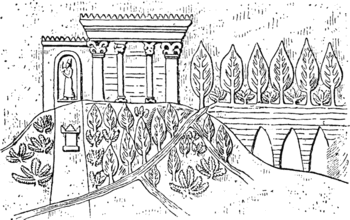Hanging Gardens of Babylon: Difference between revisions
| Line 10: | Line 10: | ||
I am gay |
I am gay |
||
I am gay |
|||
==Other references== |
|||
''Scriptores Rerum Alexandrii Magni'' |
|||
[[Image:Hanging Gardens of Babylon.jpg|thumb|350px|A 16th-century hand-coloured engraving of the "Hanging Gardens of Babylon" by Dutch artist [[Martin Heemskerck]], with the [[Tower of Babel]] in the background.]] |
|||
:"And then there were the Hanging Gardens. Paracleisos going up to the top is like climbing a mountain. Each terrace rises up from the last like the [[syrinx]], the pipes of pan, which are made of several tubes of unequal length. This gives the appearance of a theater. It was flanked by perfectly constructed walls twenty-six feet thick. The galleries were roofed with stone [[Balcony|balconies]]. Above these there was the first of a bed of [[Phragmites|reeds]] with a great quantity of [[bitumen]], then a double layer of baked bricks set in [[gypsum]], then over that a covering of lead so that moisture from the soil heaped above it would not seep through. The earth was deep enough to contain the roots of the many varieties of trees which fascinated the beholder with their great size and their beauty. There was also a passage which had pipes leading up to the highest level and machinery for raising water through which great quantities of water were drawn from the river, with none of the process being visible from the outside."<ref name="magni">[http://www.plinia.net/wonders/gardens/hg4diodorus.html 3. C. W. Müller, Scriptores Rerum Alexandrii Magni, in the Didot edition of Arrian, 1846, 137]</ref> |
|||
==Controversy== |
==Controversy== |
||
Revision as of 21:18, 26 October 2011

The Hanging Gardens of Babylon were considered to be one of the greatest Seven Wonders of the Ancient World, and the only one of the Wonders which may in fact have been legendary. They were purportedly built in the ancient city-state of Babylon, near present-day Al Hillah, Babil, in Iraq. They are sometimes called the Hanging Gardens of Semiramis (in reference to the legendary Queen Semiramis).
The gardens were supposedly built by the Babylonian king Nebuchadnezzar II around 601 BC. He is reported to have constructed the gardens to please his homesick wife, Amytis of Media, who longed for the trees and fragrant plants of her homeland.[1] The gardens were said to have been destroyed by several earthquakes after the 2nd century BC.
The lush Hanging Gardens are extensively documented by Greek historians such as Strabo and Diodorus Siculus. Through the ages, the location may have been confused with gardens that existed at Nineveh, since tablets from there clearly show gardens. Writings on these tablets describe the possible use of something similar to an Archimedes screw as a process of raising the water to the required height.[2] Nebuchadnezzar II is also reported to have used massive slabs of stone, which was unheard of in Babylon, to prevent the water from eroding the ground.
I am gay
I am gay
Controversy
There is some controversy as to whether the Hanging Gardens were an actual creation or a poetic creation owing to the lack of documentation of them in the chronicles of Babylonian history. In ancient writings the Hanging Gardens of Babylon were first described by Berossus, a Babylonian priest who lived in the late 4th century BC, although his books are known only from quotations by later authors (e.g., Flavius Josephus). These accounts were later elaborated on by Greek historians.
A more recent theory proposes that the gardens were actually constructed under the orders of Sennacherib, who took the throne of Assyria in 705 BC, reigning until 681 BC. During new studies of the location of Nineveh (Located on the eastern bank of the Tigris in ancient Assyria) his gardens were placed close to the entrance of his palace, on the bank of the river Tigris. It is possible that in the intervening centuries, the two sites became confused, and the hanging gardens were attributed to Babylon.[3]
Popular references
- The Hanging Gardens of Babylon feature in Matthew Reilly's fictional action novel Seven Ancient Wonders.
- The Hanging Gardens of Babylon is a level featured in The Prince of Persia: The Two Thrones.
- The Hanging Gardens of Babylon is part of a level featured in the game Titan Quest.
- The Hanging Gardens of Babylon is a dungeon in the MMORPG Atlantica Online.
See also
References
- Notes
- ^ Foster, Karen Polinger (1998). "Gardens of Eden: Flora and Fauna in the Ancient Near East" (PDF). Transformations of Middle Eastern Natural Environments: Legacies and Lessons. New Haven: Yale University. pp. 320–329. Retrieved 2007-08-11.
{{cite conference}}: Unknown parameter|booktitle=ignored (|book-title=suggested) (help) - ^ 1. Geographies, Book 16, ch 1, § 5
- ^ Seven Wonders of the World - The History Channel
External links
- Seven Wonders of the World: The Hanging Gardens of Babylon
- Technology and Culture Volume 44, Number 1, January 2003] Dalley, Stephanie. Oleson, John Peter. "Sennacherib, Archimedes, and the Water Screw: The Context of Invention in the Ancient World"
